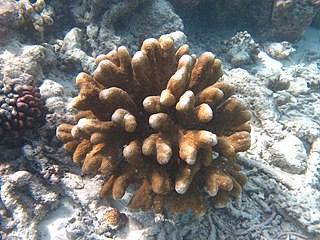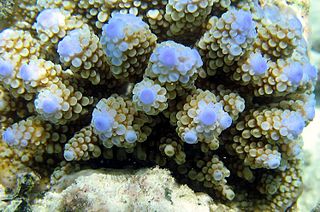
Acropora prolifera, the fused staghorn coral, is a branching, colonial, stony coral found in shallow parts of the Caribbean Sea, the Bahamas and southern Florida.

Acropora secale is a species of branching staghorn stony coral. It is found in shallow parts of the Indo-Pacific Ocean and the type locality is Sri Lanka. The oldest fossils found date back to the Pleistocene.

Acropora pulchra is a species of colonial staghorn coral in the family Acroporidae. It is found on the back fringes of reefs in shallow water in the western Indo-Pacific Ocean. The oldest fossils of this species date back to the Pleistocene.

Acropora aspera is a species of staghorn coral in the family Acroporidae. It is found on reef flats and in lagoons in very shallow water in the western Indo-Pacific Ocean.

Isopora palifera is a species of stony coral in the family Acroporidae. It is a reef building coral living in shallow water and adopts different forms depending on the water conditions where it is situated. It is found in the Western Indo-Pacific Ocean as far east as Australia.

Acropora loripes is a species of branching colonial stony coral. It is common on reefs, upper reef slopes and reef flats in the tropical Indo-Pacific. Its type locality is the Great Barrier Reef.

Acropora millepora is a species of branching stony coral native to the western Indo-Pacific where it is found in shallow water from the east coast of Africa to the coasts of Japan and Australia.

Acropora nasuta is a species of branching stony coral in the family Acroporidae. It is native to the western and central Indo-Pacific where it is found in shallow reef habitats. Like other corals of the genus Acropora, it is susceptible to coral bleaching and coral diseases and the IUCN has listed it as being "Near Threatened".

Acropora abrotanoides is a species of acroporid coral found in Indo-Pacific waters from the Red Sea and the Gulf of Aden east to the East China Sea, Japan, the central Pacific Ocean and Australia. It is found in shallow coral reefs that are exposed to the action of strong waves, at depths up to 15 m. It is vulnerable to coral bleaching, disease and crown-of-thorns starfish. It is resistant to predation as it has well-developed radial corallite lips.

Acropora muricata, commonly called staghorn coral, is a species of acroporid coral found in the Gulf of Aden, the Red Sea, Indian Ocean, Persian Gulf, Australia, central Indo-Pacific, Japan, Southeast Asia, the East China Sea and the oceanic central and western Pacific Ocean. It is found in tropical shallow reefs, slopes of reefs, and in lagoons, from depths of 5 to 30 m. It was described by Dana in 1846.
Acropora abrolhosensis is a species of acroporid coral that was first described by John Veron in 1985. Found in sheltered lagoons and shallow reefs, it is listed as a vulnerable species on the IUCN Red List. The population of the species is decreasing, and most specimens are found in Western Australia, but occurs in many other areas. It is also listed under CITES Appendix II.
Acropora awi is a species of acroporid coral that was described by Wallace and Wolstenholme in 1998. Found in fringing reefs, the slopes of shallow reefs, and sandy slopes, it occurs in a marine environment. The species is rated as vulnerable on the IUCN Red List, with a decreasing population, and is easily damaged. It can be found over a large area but is not abundant.
Acropora derawanensis is a species of acroporid coral that was first described by Carden Wallace in 1997. Found in tropical, shallow reefs sheltered from the waves in a marine environment, it is found at depths of 10 to 25 m on reef slopes. The species is rated as vulnerable on the IUCN Red List, with a decreasing population. It is not common but found over a large area, and is listed on CITES Appendix II. It is easily damaged.
Acropora hoeksemai is a species of acroporid coral that was first described by Dr. Carden Wallace in 1997. Found in shallow reefs in a marine environment, it is found at depths of 8 to 20 m. It is listed as a vulnerable species on the IUCN Red List, and has a decreasing population. It is common, listed on Appendix II of CITES, and is found over a large range.
Acropora kimbeensis is a species of acroporid coral that was first described by Dr. Carden Wallace in 1999. Found in marine, tropical, shallow reefs usually at depths of 3 to 12 m, but can occur as low as 15 m (49 ft). It is listed as a vulnerable species on the IUCN Red List, and it is thought to have a decreasing population. It is not common and found over a large area, and is listed on CITES Appendix II.
Acropora kirstyae is a species of acroporid coral that was first described by Jen Veron and C. C. Wallace in 1984. Found in marine, tropical, shallow reefs in sheltered areas usually at depths of 10 to 25 m, and also occurs in sheltered lagoons. It is listed as a vulnerable species on the IUCN Red List, and it is thought to have a decreasing population. It is not common and found over a large area, and is listed on CITES Appendix II.
Acropora kosurini is a species of acroporid coral that was first described by C. C. Wallace in 1994. Found in marine, shallow reefs, it occurs at depths of 8 to 20 m. It is listed as a vulnerable species on the IUCN Red List, and it is believed to have a decreasing population. It is rare but found over a large area, and is listed on CITES Appendix II.
Acropora loisetteae is a species of acroporid coral that was first described by C. C. Wallace in 1994. Found in marine, tropical, shallow reefs in sheltered lagoons, it is found at depths between 1 and 30 m. It is listed as vulnerable on the IUCN Red List, and it is thought to have a decreasing population. It is not common but found over a large area, and is listed under CITES Appendix II.
Acropora lokani is a species of acroporid coral that was first described by C. C. Wallace in 1994. Found in marine, shallow reefs and sheltered lagoons, it occurs at depths between 8 and 25 m. It is listed as vulnerable on the IUCN Red List, and is believed to have a decreasing population. It is not common but found over a large area, including in three regions of Indonedia, and is listed under CITES Appendix II.
Acropora papillare is a species of acroporid coral that was first described by Latypov in 1992. Found in marine, tropical, shallow reefs in areas exposed to waves, it occurs at depths of between 1 and 5 m. It is classed as a vulnerable species on the IUCN Red List, and it has a decreasing population. It is uncommon but found over a large area, including in three regions of Indonesia, and is classified under CITES Appendix II.












